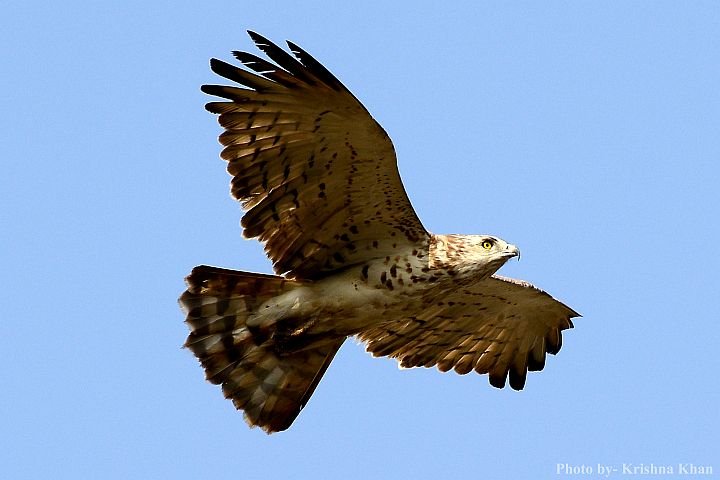March and early April brings a great joy for lovers of the spectacular Short-toed Eagle – Circaetus gallicus -Aguila culebrera when yet again they have made it across the Strait of Gibraltar to their breeding grounds in Europe. The first single birds start appearing in the Sierra de Grazalema at the end of February but the massive migration comes in March, when clouds of birds can be seen entering continental Europe.
This eagle´s appearance and its habits make it a treat to watch, whether you are a seasoned birder, a casual nature lover or a walker who maybe has never seen an eagle before. Once you have spotted this easy-to-identify, pale, graceful silhouette against the blue Andalucían sky, hovering like a kestrel while scanning the limestone rocks and scrub to find prey, you just may become a life-long fan.

There are many features which make the European Short-toed Eagle special, probably the most defining one being its diet. This eagle is a successful snake hunter, its diet being a narrow speciality as far as birds of prey are concerned.
Where do the short-toes fit in, then?
This bird has powerful but stubby toes, covered in thick scales which protect it from snake bites. When the eagle spots a snake from above using its excellent binocular vision (its eyes are very large and facing well forward) it lunges at the reptile, grabbing it with its strong toes and pecking at the head with its sharp hooked beak. The snake, in defence, will try to crawl on the bird´s wings, damaging the feathers and the struggle can be quite spectacular as the eagle does not shy away from large snakes. Once subdued the snake is swallowed whole. The bird throws its head back and using gravity and a snake-friendly gullet, let´s the prey slide bit by bit into its stomach.
Nesting and chick rearing
The Short-toed eagle nests in bushy tree-tops, such as Holm or Cork Oaks; only one egg is laid. The Short-toed “Eaglet” hatches from mid May to the beginning of June and starts flying in August, only one or two months before it is time to migrate to the tropical zone of Africa. There are well-documented cases of both juvenile and adult birds overwintering in the Sierra de Grazalema Natural Park, although it is more of an exception than a rule.
The young chick is first fed with small snake snacks and then taught to swallow the reptile whole like thick spaghetti. It is a fascinating sight to witness the adult eagles carrying wiggling snakes hanging from their beaks making the tricky delivery to the nest. The Short-toed will also pursue lizards, especially the large Ocellated Lizard which seems to be its favourite delicacy. When no snakes or lizards are available, it will cheat hunger with an occasional amphibian or even large insects.
How to identify the Short-toed Eagle – Circaetus gallicus – Aguila culebrera
Before you ask yourself what it is, it´s good to think what it is not. By far the most likely bird of prey in the skies around Grazalema in Andalusia is the large Griffon Vulture; however all of our resident and migratory eagles are smaller than the Griffon, even the powerful Golden Eagle. So, if it is a little smaller than a Griffon Vulture, we may want to start paying attention.

Very pale. The Short-toed eagle in flight will at first glance appear to be purely white underneath, at a closer look you will notice fine barring on the wings and chest. Young birds will often lack those fine dark lines. The wings are quite wide and the tail is long, often fanned out when the birds is suspended in the air.
If it hovers and it is much, much larger than a Kestrel, then it is the Short-toed Eagle. The wing beats are not as fast as the Kestrel’s but the Short-toed can stay suspended in one spot for quite a while.
Large, often fluffed up head, quite startled-looking large orange eyes, hooked beak and match-stick thin legs make up the image of a perched Short-toed. It will happily rest on rocks or in trees.
In the breeding season, or flying with the young, these birds can be quite vocal, uttering mournful, nasal shrieks, like someone suffering from a heavy cold. The parents and the young love play-fighting dive bombing each other in mid air.
These spectacular animals are not endangered in Spain at the moment but they are considered to be birds “of special interest”. They could start disappearing rapidly due to the progressive destruction of large forests and due to the thoughtless persecution of snakes which is still common in all parts of Europe. The bird´s survival depends on the availability of reptiles.
In Spanish, the Short-toed is called “la Culebrera”, the Snake Eagle, which is also an alternative, less used, English name for this impressive raptor.
Watch this fantastic footage from the Spanish wildlife show “El hombre y la tierra” with the unmistakeable narrative voice of Félix Rodríguez de la Fuente.
Iberia Nature Forum
Struggling with identifying those bugs and beasties? Why not check out the Iberia nature Forum!
Discover the Iberia Nature Forum – Environment, geography, nature, landscape, climate, culture, history, rural tourism and travel.
I’ve been living in this lovely area of Western Andalucia for the last 20 years or so and dedicate most of my time to the running of English language tourist information websites for the towns of Cádiz, Ronda, Grazalema, the famous or infamous Caminito del Rey, and also Wildside Holidays, which promotes sustainable and eco-friendly businesses running wildlife and walking holidays in Spain. My articles contain affiliate links that will help you reserve a hotel, bus, train or activity in the area. You don’t pay more, but by using them you do support this website. Thankyou!
